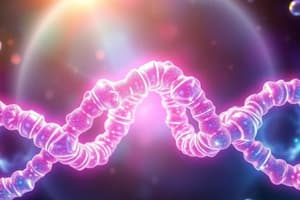Podcast
Questions and Answers
What are enzymes primarily composed of?
What are enzymes primarily composed of?
- Carbohydrates
- Nucleic acids
- Proteins (correct)
- Lipids
What is the main function of an enzyme?
What is the main function of an enzyme?
To increase the rate of chemical reactions by lowering activation energy.
Enzymes can change the thermodynamic properties of a reaction.
Enzymes can change the thermodynamic properties of a reaction.
False (B)
What is activation energy (Ea)?
What is activation energy (Ea)?
Which of the following statements about enzyme activity is true?
Which of the following statements about enzyme activity is true?
What is Km in the context of enzyme kinetics?
What is Km in the context of enzyme kinetics?
Enzymes change shape upon substrate binding, known as ______.
Enzymes change shape upon substrate binding, known as ______.
Match the following types of enzyme inhibitors with their definitions:
Match the following types of enzyme inhibitors with their definitions:
What effect do allosteric regulators have on enzymes?
What effect do allosteric regulators have on enzymes?
How does temperature affect enzyme function?
How does temperature affect enzyme function?
Penicillin acts as a reversible enzyme inhibitor.
Penicillin acts as a reversible enzyme inhibitor.
Flashcards are hidden until you start studying
Study Notes
Enzyme Overview
- Enzymes are biological catalysts that enhance the rate of chemical reactions without changing thermodynamic properties.
- Most enzymes are proteins, providing specificity and efficiency in catalyzing reactions.
- Enzyme kinetics reveals the affinity of enzymes for substrates and informs about reaction rates.
- Regulation of enzymes occurs through molecules produced by cells or drugs, modifying activity levels.
Enzyme Function
- Enzymes bind to substrates, forming or breaking covalent bonds quicker than uncatalyzed reactions.
- They lower activation energy (Ea) needed for reactions, but do not alter free energy change (delta G) or reaction direction.
Catalysis Dynamics
- Catalysts accelerate reactions in both directionalities, expediting system equilibrium without altering it.
- Enzyme specificity dictates efficient catalysis based on enzyme affinity for reactants vs. products.
- Examples include phosphoglucomutase, an enzyme moving phosphate groups in glucose metabolism.
Substrate Binding and Induced Fit
- Enzymes exhibit an active site where substrates bind; this specificity is key for optimal function.
- Binding induces conformation changes in enzymes (induced fit model), facilitating reaction.
- Substrate binding involves physical forces like hydrogen bonds and shapes may change during the reaction.
Mechanisms of Lowering Activation Energy
- Enzymes promote substrate proximity, apply physical strain, and can alter charge distributions to enhance reactivity.
- Efficiency varies; some enzymes work preferentially in one reaction direction based on substrate concentrations.
Reaction Kinetics
- Kinetics studies how enzyme-catalyzed reaction rates change over time and with varying substrate concentrations.
- Reaction rates can show a maximum speed (Vmax) at high substrate concentrations when all enzymes are saturated.
Vmax and Km
- Vmax represents the maximum rate of an enzyme-catalyzed reaction, influenced by enzyme concentration and environmental conditions.
- Km (Michaelis constant) reflects substrate concentration at which an enzyme is at half its maximum velocity, indicating enzyme affinity—lower Km signifies higher affinity.
Effects of Substrate Concentration and Enzyme Saturation
- Increasing substrate concentration enhances reaction rate until a plateau (Vmax) is reached, indicating enzyme saturation.
- Without enzymes, reaction speeds are slower, demonstrating the crucial role of enzymes in biological processes.
Enzyme Regulation
- Enzymes are tightly regulated to avoid continuous activity, maintaining necessary levels of biochemical reactions.
- Allosteric regulators alter enzyme activity by changing the shape of the active site, which can either inhibit or activate enzymatic action.
Inhibitors
- Reversible inhibitors, including competitive and non-competitive, bind temporarily and can affect rates of catalysis.
- Competitive inhibitors block the active site directly, while non-competitive inhibitors alter enzyme function without directly blocking the site.
- Irreversible inhibitors form permanent bonds with enzymes, inhibiting their activity and often leading to cell toxicity.
Penicillin as an Irreversible Inhibitor
- Functions by covalently binding to bacterial enzymes, interrupting cell wall synthesis, effective mainly against gram-positive bacteria.
- Works through inhibiting glycopeptide transpeptidase, crucial for peptidoglycan formation in bacterial cell walls.
Studying That Suits You
Use AI to generate personalized quizzes and flashcards to suit your learning preferences.




